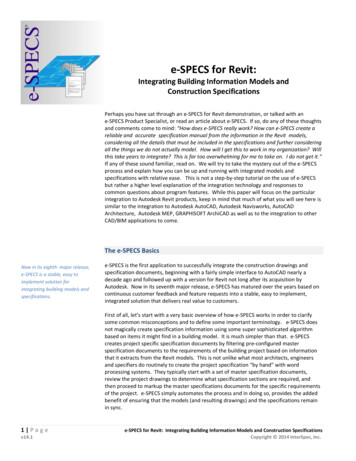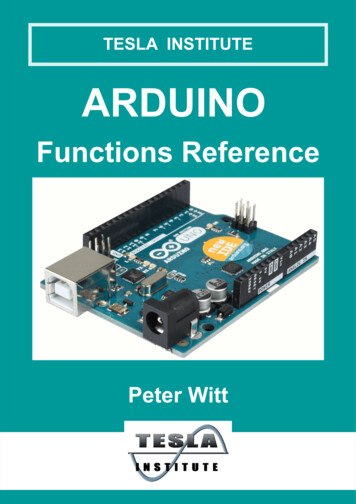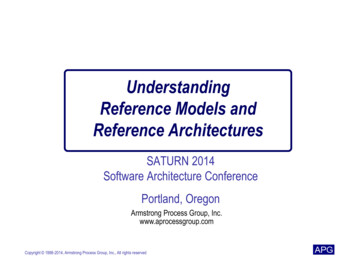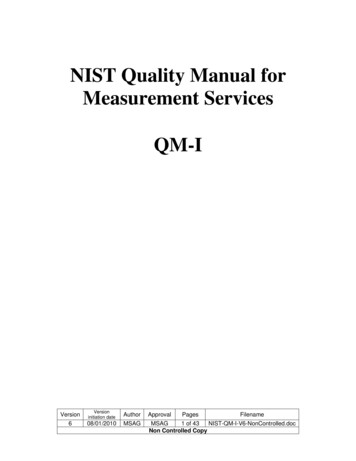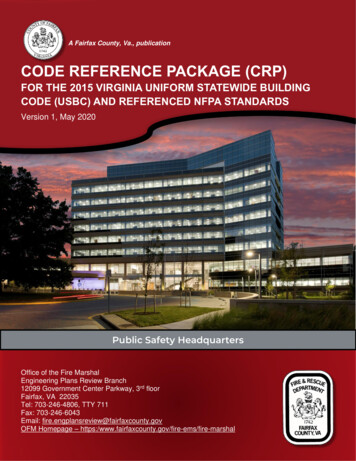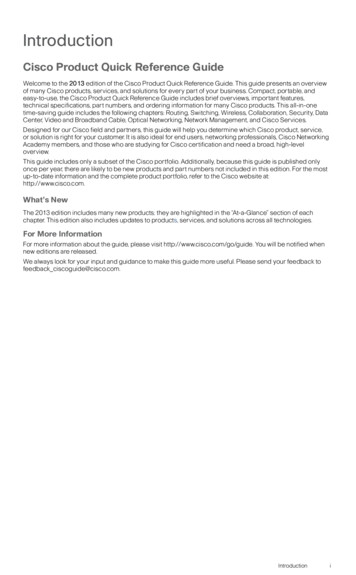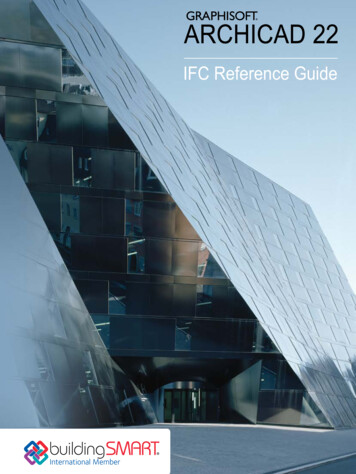
Transcription
IFC Reference GuideIFC Reference Guide forARCHICAD 22
GRAPHISOFT Visit the GRAPHISOFT website at www.graphisoft.com for local distributor and productavailability information.IFC Reference Guide for ARCHICAD 22Copyright 2018 by GRAPHISOFT, all rights reserved. Reproduction, paraphrasing ortranslation without express prior written permission is strictly prohibited.TrademarksARCHICAD is a registered trademark of GRAPHISOFT.All other trademarks are the property of their respective holders.
ContentsWorking with IFC 5IFC File Types Supported by ARCHICAD . . . . . . . . . . . . . . . . . . . . . . . . . . . . . . . . . . . . . . . . . . . . 7ARCHICAD Classifications and Categories in IFC . . . . . . . . . . . . . . . . . . . . . . . . . . . . . . . . . . . . 8Export IFC Model from ARCHICAD . . . . . . . . . . . . . . . . . . . . . . . . . . . . . . . . . . . . . . . . . . . . . . . 11Import IFC Model to ARCHICAD . . . . . . . . . . . . . . . . . . . . . . . . . . . . . . . . . . . . . . . . . . . . . . . . . . 15Open IFC Model . . . . . . . . . . . . . . . . . . . . . . . . . . . . . . . . . . . . . . . . . . . . . . . . . . . . . . . . . . . . . . . 17Merge IFC Project . . . . . . . . . . . . . . . . . . . . . . . . . . . . . . . . . . . . . . . . . . . . . . . . . . . . . . . . . . . . . . 19Hotlink IFC File . . . . . . . . . . . . . . . . . . . . . . . . . . . . . . . . . . . . . . . . . . . . . . . . . . . . . . . . . . . . . . . . 25Detect IFC Model Changes . . . . . . . . . . . . . . . . . . . . . . . . . . . . . . . . . . . . . . . . . . . . . . . . . . . . . . 28Update with IFC Model . . . . . . . . . . . . . . . . . . . . . . . . . . . . . . . . . . . . . . . . . . . . . . . . . . . . . . . . . 34IFC Project Manager . . . . . . . . . . . . . . . . . . . . . . . . . . . . . . . . . . . . . . . . . . . . . . . . . . . . . . . . . . . 37Functions of the IFC Project Manager . . . . . . . . . . . . . . . . . . . . . . . . . . . . . . . . . . . . . . . . . 38Navigating in the IFC Project Manager: Tree Structure . . . . . . . . . . . . . . . . . . . . . . . . . . . . 39Navigating in IFC Project Manager: Attributes and Properties . . . . . . . . . . . . . . . . . . . . . . 43Assign or Edit IFC Property/Attribute Values . . . . . . . . . . . . . . . . . . . . . . . . . . . . . . . . . . . . . 46Create New, Custom IFC Property or Classification . . . . . . . . . . . . . . . . . . . . . . . . . . . . . . . 47Apply Predefined Rules . . . . . . . . . . . . . . . . . . . . . . . . . . . . . . . . . . . . . . . . . . . . . . . . . . . . . . 51Assignments in IFC Project Manager . . . . . . . . . . . . . . . . . . . . . . . . . . . . . . . . . . . . . . . . . . 59Type Products in IFC Project Manager . . . . . . . . . . . . . . . . . . . . . . . . . . . . . . . . . . . . . . . . . 64Manage IFC Data at Element Level . . . . . . . . . . . . . . . . . . . . . . . . . . . . . . . . . . . . . . . . . . . . . . . 70IFC Local Preferences . . . . . . . . . . . . . . . . . . . . . . . . . . . . . . . . . . . . . . . . . . . . . . . . . . . . . . . . . . 72Find and Select Elements by IFC Data . . . . . . . . . . . . . . . . . . . . . . . . . . . . . . . . . . . . . . . . . . . . 73Scheduling Elements with IFC Data . . . . . . . . . . . . . . . . . . . . . . . . . . . . . . . . . . . . . . . . . . . . . . 78IFC Translators: Overview . . . . . . . . . . . . . . . . . . . . . . . . . . . . . . . . . . . . . . . . . . . . . . . . . . . . . . . 80Translators for Import (Detailed Settings) . . . . . . . . . . . . . . . . . . . . . . . . . . . . . . . . . . . . . . . . . 86Model Filter for IFC Import . . . . . . . . . . . . . . . . . . . . . . . . . . . . . . . . . . . . . . . . . . . . . . . . . . 89Type Mapping for IFC Import . . . . . . . . . . . . . . . . . . . . . . . . . . . . . . . . . . . . . . . . . . . . . . . . 91Property Mapping for IFC Import . . . . . . . . . . . . . . . . . . . . . . . . . . . . . . . . . . . . . . . . . . . . . 93Using the Mapping Table . . . . . . . . . . . . . . . . . . . . . . . . . . . . . . . . . . . . . . . . . . . . . . . . 97Assigning Property Values in ARCHICAD (Based on IFC Property Mapping) . . . . 100Geometry Conversion for IFC Import . . . . . . . . . . . . . . . . . . . . . . . . . . . . . . . . . . . . . . . . . 106Layer Conversion for IFC Import . . . . . . . . . . . . . . . . . . . . . . . . . . . . . . . . . . . . . . . . . . . . . 109Material and Surface Conversion . . . . . . . . . . . . . . . . . . . . . . . . . . . . . . . . . . . . . . . . . . . . 113Translators for Export (Detailed Settings) . . . . . . . . . . . . . . . . . . . . . . . . . . . . . . . . . . . . . . . . 116Model Filter for IFC Export . . . . . . . . . . . . . . . . . . . . . . . . . . . . . . . . . . . . . . . . . . . . . . . . . . 1203
Type Mapping for IFC Export . . . . . . . . . . . . . . . . . . . . . . . . . . . . . . . . . . . . . . . . . . . . . . . . 122Geometry conversion for IFC Export . . . . . . . . . . . . . . . . . . . . . . . . . . . . . . . . . . . . . . . . . . 125Property Mapping for IFC Export . . . . . . . . . . . . . . . . . . . . . . . . . . . . . . . . . . . . . . . . . . . . 135Using Property Mapping . . . . . . . . . . . . . . . . . . . . . . . . . . . . . . . . . . . . . . . . . . . . . . . . . . . 138Data Conversion for IFC Export . . . . . . . . . . . . . . . . . . . . . . . . . . . . . . . . . . . . . . . . . . . . . 147IFC Global Unique Identifier Attribute (GlobalId) . . . . . . . . . . . . . . . . . . . . . . . . . . . . . . . . 152Unit Conversion for IFC Export . . . . . . . . . . . . . . . . . . . . . . . . . . . . . . . . . . . . . . . . . . . . . . 153Filter Model at Import (Secondary Filter) . . . . . . . . . . . . . . . . . . . . . . . . . . . . . . . . . . . . . . . . . 154Filter Model at Export . . . . . . . . . . . . . . . . . . . . . . . . . . . . . . . . . . . . . . . . . . . . . . . . . . . . . . . . . 157Appendix: IFC Terms and Concepts . . . . . . . . . . . . . . . . . . . . . . . . . . . . . . . . . . . . . . . . . . . . . 159Model View Definitions . . . . . . . . . . . . . . . . . . . . . . . . . . . . . . . . . . . . . . . . . . . . . . . . . . . . . 160IFC Data Types . . . . . . . . . . . . . . . . . . . . . . . . . . . . . . . . . . . . . . . . . . . . . . . . . . . . . . . . . . . 162Appendix: IFC Data Mapping in ARCHICAD . . . . . . . . . . . . . . . . . . . . . . . . . . . . . . . . . . . . . . . 171Predefined Property Mapping (Export ARCHICAD to IFC) . . . . . . . . . . . . . . . . . . . . . . . . . 172Built-in IFC Element Type Mapping for ARCHICAD . . . . . . . . . . . . . . . . . . . . . . . . . . . . . . . 178Data Types for Properties in IFC and ARCHICAD . . . . . . . . . . . . . . . . . . . . . . . . . . . . . . . . 188Index 1894
Working with IFCIFC (Industry Foundation Classes) is an open, neutral data exchange format. It is optimizedfor OPEN BIM- and model-based interoperability among disciplines, primarily in the AECindustry.BIM, or “Building Information Modeling,” is one of the biggest advances in the buildingindustry’s working methods since the introduction of CAD software. BIM is notsynonymous with 3D projects. Three-dimensional geometric representation is only onepart of the digital deliverables. A project includes non-graphical information, such ascalculations, that are used in surveying, facility management and energy calculation. Aprerequisite for a successful BIM project is that intelligent information can be exchangedbetween different software and even operating systems, throughout the stages of thebuilding process. This interoperability demands a neutral file format with an openstandard that supports different systems. IFC is such a system, enabling us to synchronizebuilding models between the disciplines much more easily.The IFC format is used for the efficient import and export of 3D elements and related nongeometric data, regardless of the application used to create the model. The IFC format isISO-certified and can be integrated into any existing quality assurance polices your officemay have. IFC is developed in part by buildingSMART (formerly the IAI - the InternationalAlliance for Interoperability).GRAPHISOFT has played an active role within the buildingSMART organization since 1996and supports the IFC standard. Through IFC, ARCHICAD can communicate with otherdisciplines within the context of the building model. The building model can be exportedback to literally hundreds of other systems that support IFC.The list of registered IFC supporter applications (by functional category/design disciplines) isavailable hereARCHICAD supports the import and export of both IFC2x3 and IFC4 versions. IFC data aremanaged according to the latest worldwide-certified IFC standard, IFC2x3 TC1 (TechnicalCorrigendum 1).For more information, see the buildingSMART website.This chapter provides an insight into the IFC standard and how it works in ARCHICAD.Related TopicsIFC File Types Supported by ARCHICADARCHICAD Classifications and Categories in IFCExport IFC Model from ARCHICADImport IFC Model to ARCHICADHotlink IFC FileDetect IFC Model ChangesUpdate with IFC ModelIFC Project Manager5
Manage IFC Data at Element LevelIFC Local PreferencesFind and Select Elements by IFC DataScheduling Elements with IFC DataIFC Translators: OverviewTranslators for Import (Detailed Settings)Translators for Export (Detailed Settings)Filter Model at Import (Secondary Filter)Filter Model at ExportAppendix: IFC Terms and ConceptsAppendix: IFC Data Mapping in ARCHICAD6
IFC File Types Supported by ARCHICADARCHICAD supports the export and import of the following IFC data file formats:– .ifc: the default IFC exchange format using the STEP physical file structure– .ifcXML: IFC data file using the XML document structure. This format is recommendedfor architects whose partners’ applications cannot read the original .ifc format, but canmanage XML databases (such as budget, energy calculations, etc.). This format deliversthe same model information as the plain .ifc format, but the elements and theirproperties are stored in a more informative structure. An .ifcXML file is normally 300400% larger than an .ifc file.– .ifcZIP: IFC data file using the ZIP compression algorithm. It is the compressed versionof .ifc or .ifcXML. An .ifcZIP file usually compresses an .ifc down by 60-80% and an.ifcXML file by 90-95%.Note: .ifcZIP is compatible with e.g. Windows compressed folders, WinZip, etc. So if therecipient cannot read .ifcZIP, then a ZIP extractor application can open the file into .ifcor .ifcXML format.7
ARCHICAD Classifications and Categoriesin IFCElement Classifications for IFCStructural Function Category for IFCPosition Category for IFCElement Classifications for IFCIn ARCHICAD, you can optionally assign one or more classifications to any project element.A classification makes parameters and functions available to these elements for use byother applications: to organize project data, to make models transparent, to locateelements, for listing purposes, to share exact data, etc.For each construction element, classifications can be set in the Classification andProperties panel of its Settings dialog box.ARCHICAD provides a flexible way to classify elements according to any national orcompany standard classification system. You can assign one Classification value perClassification System in the Elements’ Settings dialog, or from the Interactive Schedule.Element classification affects the IFC export process: each element will be saved to the IFCmodel according to an IFC Type. This is displayed in the “IFC Type” item in the Classificationand Properties panel (under IFC Properties). Thus, if you classify a slab as a ceiling inARCHICAD, the target program will interpret this element as a ceiling.Note: The IFC Type Mapping of ARCHICAD elements by classification depends on theType Mapping for Export setting of the current Preview Translator. See IFC Translators:Overview.8
Structural Function Category for IFC“Load-Bearing Element” or “Non-Load-Bearing Element”In collaborating with partners who are using structural programs, you can export yourARCHICAD model to IFC format: the Structural Function classification (assigned inARCHICAD) automatically adds the “load-bearing” property to structural elements in theexport file.Note: By default, Revit Structure will display only walls that have the “load-bearing”property in the “Structural” discipline views. But, if you forget to classify required wallsas “Load-Bearing Elements” in ARCHICAD, the structural engineers can also change thebearing function of walls, or they can apply another display discipline (e.g.“Architectural”) in order to show all walls exported from ARCHICAD.The current IFC standard supports the export of the “load-bearing” IFC property onlyfor the following elements: Wall, Slab, Column, Beam, Roof; elements classified as suchin ARCHICAD; and objects having these sub-types.If you have classified model elements as “Load-Bearing Elements”, then you can use thePartial Structure Display “Core of Load-Bearing Elements Only” option to display thoseelements only. This is particularly useful if you wish to export only load-bearing elementsto a structural engineer: in this case, just use the “visible elements” export mode on a viewthat uses this Partial Structure Display option.9
This category is useful for listing purposes - for example, you can calculate the materialsneeded for all load-bearing walls or columns, separately from materials of non-loadbearing elements.Criteria in the Find & Select dialog box include: search for those elements that have beendefined as load-bearing or non-load-bearing, or whose Structural Function category is“Undefined”. Since IFC export can be limited
defined as load-bearing or non-load-bearing, or whose Structural Function category is “Undefined”. Since IFC export can be limited to selected elements only, you can - for example - export all selected elements defined load-bearing (not just their Core only, as described in the example above). The load-bearing data is also a standard .





